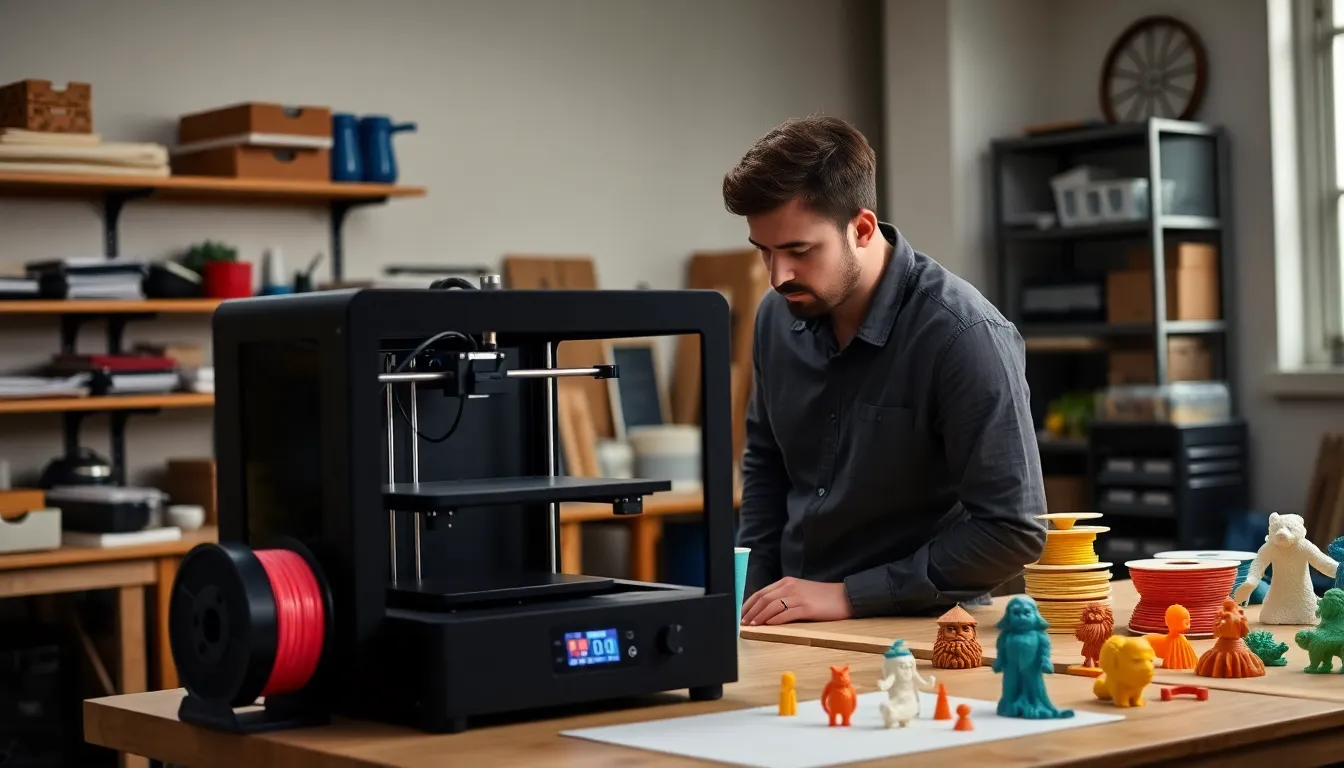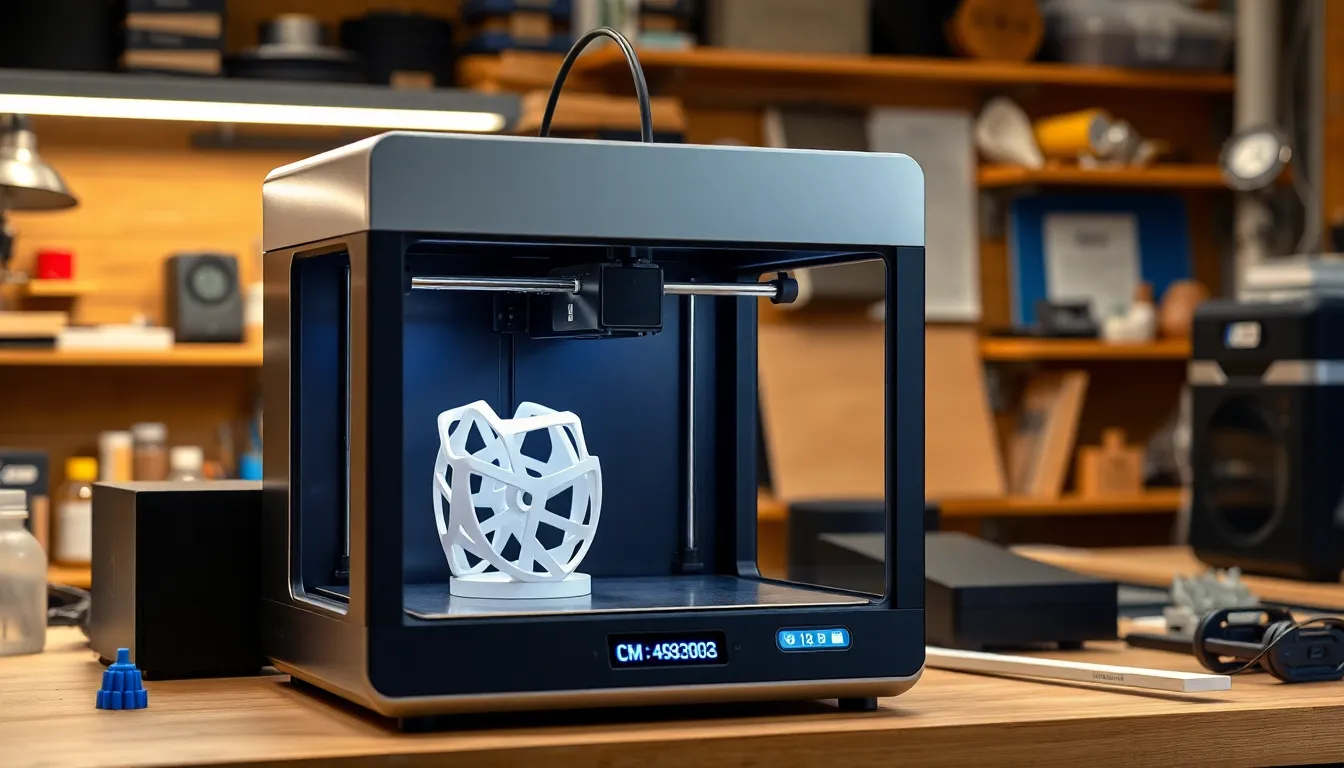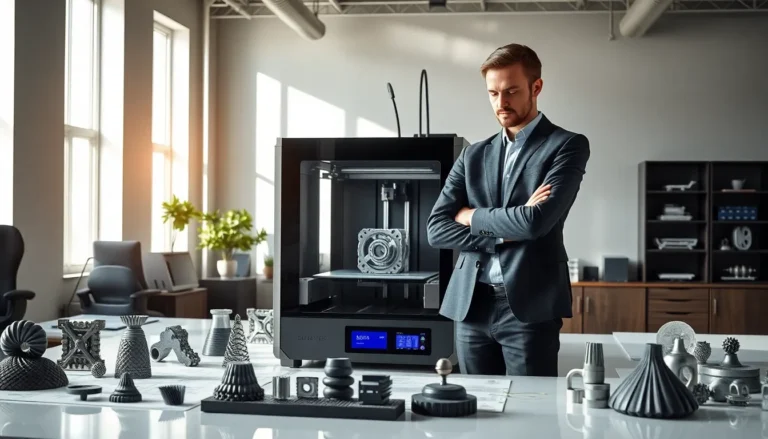Table of Contents
ToggleIn a world where creativity knows no bounds, desktop 3D printers are the magic wands every maker dreams of. Imagine turning your wildest ideas into tangible objects right from your home office. Whether you’re crafting a miniature dinosaur for your desk or prototyping the next big invention, these printers are like a genie in a box—minus the three-wish limit.
Overview of Desktop 3D Printers
Desktop 3D printers serve as accessible tools that empower individuals to create intricate designs and prototypes. Such printers allow users to produce objects at a fraction of the cost and time compared to traditional manufacturing methods. Various technologies, including Fused Deposition Modeling (FDM) and Stereolithography (SLA), facilitate the printing process for diverse materials.
FDM printers, for instance, melt thermoplastic filament to build layers. Meanwhile, SLA printers use ultraviolet light to cure resin, achieving finer details and smoother finishes. Users often choose their printer type based on the desired output quality and material requirements.
Many desktop 3D printers feature user-friendly interfaces and software that streamline the design process. With compatible CAD software, designers can create models and export them directly for printing, enhancing efficiency. Numerous online communities also provide resources, including tutorials, design files, and troubleshooting assistance, which foster creative exploration.
Print volume varies significantly among different models. Some entry-level printers offer a build size suitable for small items, while others accommodate larger objects for professional applications. This flexibility accommodates a range of projects, from hobbyist creations to commercial prototypes.
Cost can also vary greatly across the market. Budget-friendly options exist for hobbyists, while advanced models targeting professionals come with higher price points. Evaluating features and specifications plays a crucial role in selecting the appropriate printer.
Desktop 3D printers exemplify innovation by democratizing access to manufacturing technologies. They open doors for creativity, enabling makers and professionals to turn concepts into tangible products, thereby transforming industries and fostering the spirit of innovation.
Key Features to Consider


When selecting a desktop 3D printer, several essential features warrant attention. These elements influence overall performance and user experience significantly.
Build Volume
Build volume defines the maximum size of objects a printer can create. Evaluating the build volume helps determine suitability for specific projects. Many hobbyists favor printers that accommodate smaller models, while professionals often require larger capacities for intricate prototypes. Some models offer a build volume of 220 x 220 x 250 mm, sufficient for various tasks. Others may reach dimensions of 300 x 300 x 400 mm, allowing for expansive prints. Producers should choose a printer that aligns with intended applications to maximize effectiveness.
Printing Technology
Printing technology is crucial, as it impacts both print quality and material compatibility. Fused Deposition Modeling (FDM) operates by extruding melted filament layer by layer, making it popular for its versatility. Stereolithography (SLA), on the other hand, utilizes ultraviolet light to cure resin, providing superior detail and surface finish. Users should consider the specific benefits of each technology based on project requirements. It’s also important to note the material options available, which might range from standard plastics to specialized filaments. Understanding these technologies helps inform more effective purchase decisions.
Popular Desktop 3D Printer Models
Various desktop 3D printer models offer unique features and advantages, making them suitable for different users and applications. Here are a couple of popular options.
Model A: Features and Benefits
The Creality Ender 3 stands out for its affordability and reliability, appealing to beginners and experienced users alike. Featuring a build volume of 220 x 220 x 250 mm, it accommodates a range of projects, from small trinkets to larger prototypes. Users appreciate the easy assembly process and the active online community that offers support and resources. This model utilizes Fused Deposition Modeling technology, ensuring consistent results with various filament types, including PLA and ABS. Furthermore, the printer’s upgradable components allow for future enhancements, fostering a user’s growth and experimentation.
Model B: Features and Benefits
The Anycubic Photon Mono excels in delivering high-resolution prints with its Stereolithography technology, which utilizes UV light to cure resin. Printing with a build volume of 130 x 80 x 165 mm, it captures intricate details, making it ideal for figurines and detailed prototypes. Users value the fast printing speed and the ease of post-processing due to its design. The intuitive touch screen interface enhances the user experience, allowing for seamless navigation through settings. Additionally, its compatibility with various resins broadens the range of materials available for users seeking versatility in their projects.
Applications of Desktop 3D Printers
Desktop 3D printers serve various applications across multiple industries, enhancing creativity and efficiency. Their prototyping capabilities and role in education showcase their versatility and importance.
Prototyping
Prototyping stands out as a primary application of desktop 3D printers. Designers create rapid prototypes, transforming concepts into physical models quickly and cost-effectively. These printers help in visualizing ideas, enabling adjustments before full-scale production. Engineers utilize desktop 3D printers to test functionality, leading to improved designs and reduced time-to-market. Advanced features allow for creating intricate prototypes, which would be difficult with traditional methods. Industries such as automotive and consumer electronics rely on these capabilities to streamline development processes.
Educational Use
Educational institutions integrate desktop 3D printers into curricula, enhancing hands-on learning. Students engage in projects that foster creativity and problem-solving skills. Teachers introduce technology across subjects, from art to engineering. By using 3D printers, learners experience the entire design process, from ideation to creation. Collaboration occurs as students work in teams to bring their designs to life. Institutions also utilize desktop 3D printers to support STEM initiatives, promoting interest in science and technology careers. Access to this technology empowers the next generation of innovators and creators.
Desktop 3D printers are revolutionizing the way individuals and industries create. Their combination of accessibility and advanced technology allows users to bring their ideas to life with ease. Whether for personal projects or professional applications, these printers cater to a wide range of needs and budgets.
As the technology continues to evolve, the possibilities are virtually limitless. From detailed prototypes to educational tools, desktop 3D printers empower creators and innovators alike. With the right model and features, anyone can harness this technology to transform their visions into reality. The future of making is bright, and desktop 3D printers are at the forefront of this exciting evolution.




